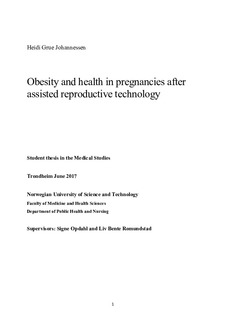Obesity and health in pregnancies after assisted reproductive technology
Master thesis
Permanent lenke
http://hdl.handle.net/11250/2456131Utgivelsesdato
2017Metadata
Vis full innførselSamlinger
Sammendrag
Objective: To compare the association of maternal pre-pregnancy body mass index (BMI) with adverse perinatal and maternal outcomes in pregnancies following spontaneous and assisted conception in a large nation-wide cohort.
Design: Population-based cohort study. Data from the Medical Birth Registry of Norway and the Norwegian National Education Database (NUDB) at Statistics Norway.
Setting: Nation-wide registry-based observational study
Patients: A total of 227 765 singleton deliveries; 6 760 after assisted reproductive technology (ART) and 221 005 after spontaneous conception (SC).
Interventions: None.
Main outcome measures: Preterm birth (< 37 weeks), small for gestational age (SGA), large for gestational age (LGA), perinatal death (stillbirth and live birth with death within the first 28 days), hypertensive disorders in pregnancy (HDP; gestational hypertension and preeclampsia), gestational diabetes mellitus, induction of delivery and caesarean section. Associations between maternal pre-pregnancy BMI and outcomes were analysed in logistic regression models, reporting odds ratios and risk differences.
Results: In general, the risks of all the outcomes were higher in ART than in SC across all categories of maternal pre-pregnancy BMI. For all outcomes except SGA, the risk was highest for women with a BMI ³30 kg/m2 . The risk of perinatal death increased strongly with increasing BMI in both SC and ART, and was higher in ART pregnancies than in SC pregnancies across all categories of maternal BMI. The highest risk of perinatal death was found for women with a BMI ³30 kg/m2 (0.6% for SC and 1.1% for ART). The risk of HDP increased strongly with increasing BMI in both ART and SC pregnancies. For HDP, the risk difference between women with BMI ³30 kg/m2 and BMI 20-24 kg/m2 was 6.9% and 8.6% for SC and ART pregnancies, respectively.
Conclusions: The associations between maternal BMI and adverse perinatal and maternal outcomes were similar after ART and spontaneous conception, but the absolute risks were higher after ART conception.
